The travel atmosphere in Chiang Mai feels quite different from Bangkok. As the second-largest city in Thailand, Chiang Mai is situated in the northern region. It has hosted the SEA Games and Asian Games in the past. Its location in the north made me confident that the weather would be cooler than Bangkok, so I prepared a jacket before leaving Batam. I traveled to Chiang Mai after celebrating New Year’s in Bangkok.

From Bangkok to Chiang Mai, there are several transportation options, including buses, trains, and planes. I opted for the bus even though the journey takes longer. I chose an overnight departure to arrive in Chiang Mai in the morning, saving on one night’s accommodation.
Even though it was peak season, I didn’t purchase a ticket in advance. I was confident I could buy one directly at Mochit Terminal. I left my hostel in the Pratunam area in the evening, heading to Mochit via the BTS Skytrain on the Payathai-Mochit route. From the final BTS station, I took a bus to Mochit Bus Terminal, about 2 kilometers away.
Mochit Bus Terminal is easy to spot from the main road due to its large building and signage, so no need to worry about getting lost. Inside, there are many ticket counters lined up. I searched for a counter selling bus tickets to Chiang Mai.
There were several counters, and the prices offered were nearly the same. I chose one in a corner because it had the cheapest price and matched my desired schedule. Tickets to Chiang Mai ranged between 400 and 500 THB. The buses were comfortable, with reclining seats.
The bus departed at around 10 p.m. and arrived at Chiang Mai Arcade Bus Terminal at dawn. It was still very dark, but the terminal was already bustling with locals and tourists. The cold weather made me shiver, so I hurried inside the waiting area to warm up, sitting on a long bench wrapped in my jacket.
Once the sun started to rise, I looked for a canteen to have breakfast. There were several shops and cafes inside the terminal, but they were pricey. I found a canteen at the back of the terminal, where many locals were eating. I joined them and ordered hot tea.
Even after sunrise, I didn’t head straight to my accommodation since check-in wasn’t until 1 p.m. I returned to the terminal’s waiting area after breakfast, observing the locals. Suddenly, music started playing, and everyone stood up.
At first, I was confused but then remembered the Thai custom of playing the national anthem every morning, during which locals stand in respect. Realizing I was the only one still seated, I quickly stood up to join them. Once the anthem ended, everyone sat down and resumed their activities.
Outside the terminal, the streets were already busy with traffic. Locals were starting their day. I left the terminal and headed to Chiang Mai’s city center. The bus terminal is located on the eastern outskirts, about 5-6 kilometers from the Old Town, the city’s heart. My hostel was right on the corner of the Old Town.
To get from the bus terminal to the city center, there’s a bus service similar to Jakarta’s busway system. It’s blue and called RTC Chiang Mai City Bus. The fare is 20 THB per trip. The green route passes the bus terminal and Old Town. Once in the city center, I first visited the markets outside the Old Town near the riverside. There are several markets close to each other.
According to the map, the nearby markets include Chiang Mai Municipal Market, Nawarat Market, Tom Lam Yai Market, and Warorot Market. I explored the markets, which sell a variety of snacks, food, souvenirs, and gifts. I spent a lot of time observing the vendors and their goods. The markets are clean and well-organized, making it pleasant to browse each stall and shop.
Inside, there were also food and drink vendors. One stall in the center of the market resembled a bar with high chairs. I ordered iced Thai tea and bread there. Relaxing with my drink, the thirst from exploring the market melted away.
By midday, I left the market and walked to the Old Town, enjoying the city’s ambiance. Chiang Mai’s city center isn’t as bustling or glittering as Bangkok’s, even though it’s the second-largest city in Thailand. Traffic is light, and there are hardly any tall buildings. Its calmer vibe made me feel comfortable.

Pedestrians are treated with courtesy, similar to Europe. When crossing the street, vehicles stop to let you pass. Near the Old Town, I saw a long red-brick wall—part of the square-shaped wall surrounding the Old Town. A moat separates the Old Town from the outer city.
Curious, I walked along the road outside the Old Town wall, parallel to its shape. After a few hundred meters, I found one of the Old Town’s gates, Tha Phae Gate, a well-known landmark of Chiang Mai. It was bustling with tourists taking photos or feeding pigeons. The classic and Instagram-worthy architecture makes it a popular photo spot.
In front of Tha Phae Gate is an open square. The gate was built in the 13th century, in 1296, by King Mangrai when Chiang Mai was the capital of the Lanna Kingdom. Over time, parts of it have collapsed due to human activity.
The area around Tha Phae Gate is lively, with many hotels, restaurants, bars, cafes, Thai massage parlors, souvenir shops, mini-marts, and markets. If you’re lucky, you might catch tourism-related events like music concerts, cultural performances, or festivals. It’s also a fun hangout spot, especially on Saturday nights.
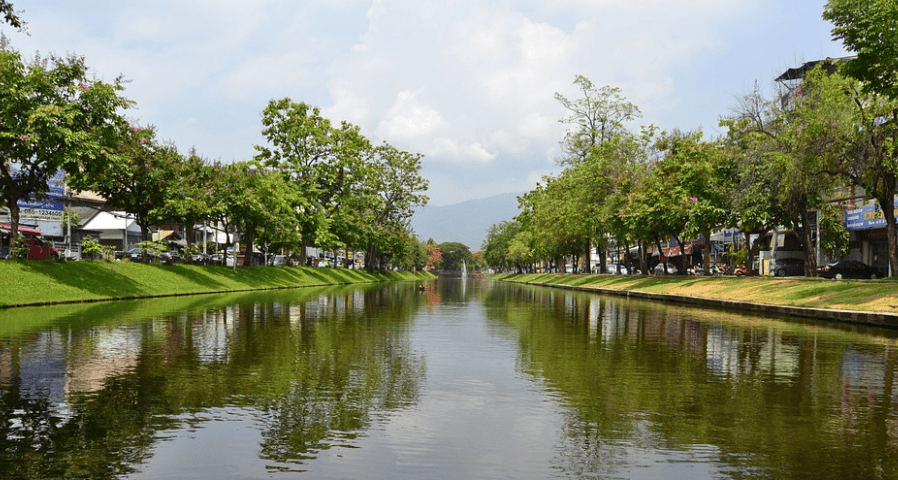
Besides Tha Phae Gate, there are four other gates: Chang Puek Gate in the north, Suan Dok Gate in the west, and Chiang Mai Gate and Suan Proong Gate in the south. As I continued walking outside the Old Town wall, I reached the northern Sri Phum Corner. Each corner of the Old Town wall has a name, and the walls there are thicker.
From Sri Phum Corner, I turned west and passed Chang Puek Gate. This gate was quiet compared to the bustling Tha Phae Gate. Continuing west, I arrived at Hua Lin Corner in the northwest. From here, I made my way to my accommodation, Bed Bike Hostel, where I had booked two nights for 343 THB. The hostel was excellent.
From Pagoda to Pagoda
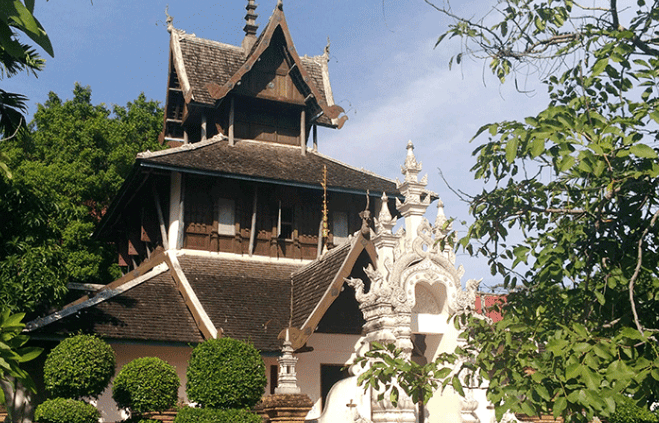
During my three-day stay in Chiang Mai, I focused solely on exploring the Old City and its surroundings. Although there are numerous other attractions outside the Old City, they are located far from the city center, requiring a rental vehicle—at least a motorbike. In contrast, the Old City and nearby areas are easily explored on foot.
The main attractions within and around Chiang Mai’s Old City are its pagodas, or wats. The Old City alone boasts dozens of intriguing pagodas, with countless more in its surrounding areas. There are so many that I lost track of their names, except for the most famous ones.
Chiang Mai’s pagodas are distinct from those in Bangkok, which are predominantly golden. Here, you’ll find a mix of golden structures and dark wooden tones, all adorned with unique Lanna architecture and ornaments. From my first day, visiting pagodas was on my list. Keep in mind that some pagodas charge an entry fee, so it’s wise to check before entering. I began my journey with those outside the Old City walls.
Wat Upakhut
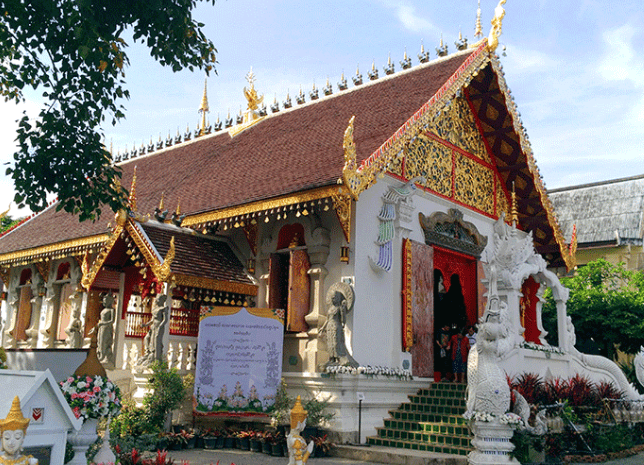
I discovered Wat Upakhut (or Wat Upakut) by accident while searching for a mosque east of the Old City. Before reaching the mosque, I was drawn to this charming pagoda located along the main Tha Phae Road, which ends at the river.
Legend has it that Wat Upakhut was once a much larger temple complex but was downsized and lost several structures when the neighboring Buddha Puttasatharn complex was built. Despite these changes, Wat Upakhut remains a key location for festivals due to its prime position near the city’s historic commercial district. Entry is free.
The complex features two temples and a chedi (stupa). The larger temple is particularly striking, with its entrance guarded by two plain white naga statues and flanked by peacock figures decorated with colorful glass accents. A modest alcove at the base of the stairs holds a revered monk’s statue.
Wat Mahawan
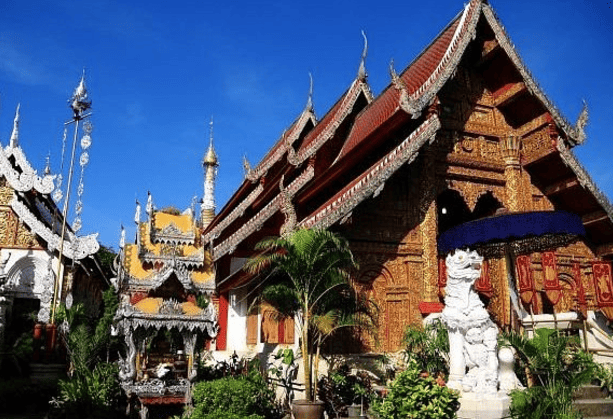
Another pagoda outside the Old City is Wat Mahawan, built in the 1870s. Located on Tha Phae Road near Tha Phae Gate, this small temple complex has closely packed structures, including a main temple, a smaller one, a chedi, and additional buildings. The main hall is often locked.
The temple showcases classic Lanna-style architecture, with golden floral motifs that faintly resemble Minangkabau house decorations. The entrance is guarded by two plain plaster chinthes (Burmese-style lions). Below the entrance, two golden Devata statues stand on either side, one praying and the other with hands over the chest. Entry to this peaceful site is free, and when I visited, it was almost deserted, allowing me to fully enjoy its serene beauty.
Wat Chedi Luang
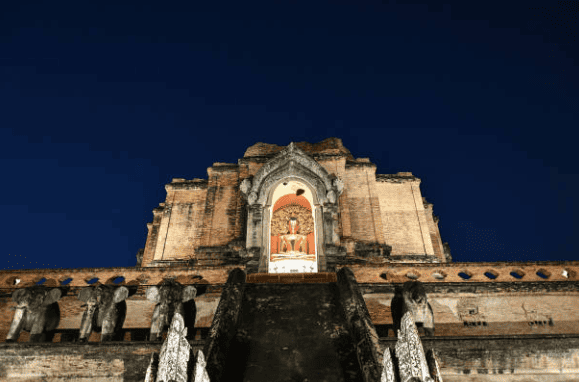
On my second day, I ventured into the Old City and visited Wat Chedi Luang, a must-see attraction in Chiang Mai. While ancient ruins are common in Chiang Mai and Thailand, Wat Chedi Luang stands out for its majestic beauty.
Built in 1401, this impressive structure suffered damage during an earthquake in 1545. Even so, the ruins remain extraordinary, with remnants of elephant statues still visible.
Under a large rubber tree near the entrance stands a small shrine called Lak Muang, built in 1940. It houses the guardian spirit of Chiang Mai. Tradition holds that if this tree were to fall, it would bring disaster to the city. Wat Chedi Luang is a must-visit destination when in Chiang Mai.
Wat Phra Singh
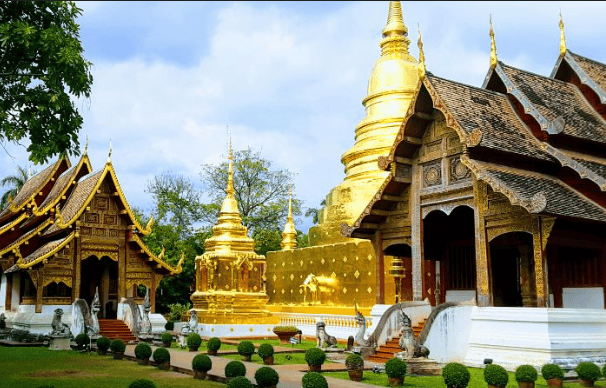
Wat Phra Singh is perhaps the most revered temple in Chiang Mai after Wat Phra That Doi Suthep. This temple complex comprises three main halls and is renowned for its elegant decorations and murals depicting the lives of locals from centuries ago.
Located at the western end of Ratchadamnoen Road within the Old City walls, the Lanna-style roofs and sparkling vihara captivate visitors. The temple is lively year-round, especially during the Songkran (Thai New Year) festival in mid-April.
Wat Buppharam
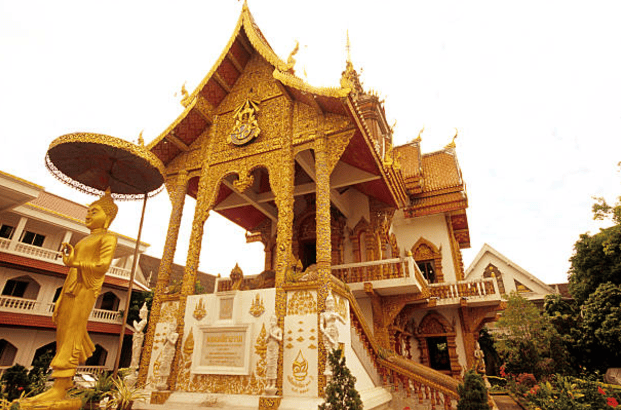
Situated along a bustling tourist route, Wat Buppharam features numerous attractions, including a giant white teak Buddha statue from the 1600s—the largest in Thailand. The site also includes an impressive library, sacred buildings, and quirky statues, such as one of Donald Duck.
On my first day, I stopped by but hesitated to enter upon seeing a ticket counter. I finally visited on my second day when a friend from America invited me along and even covered the 20 THB entry fee.
Built in 1497 by King Mueangkaeo of the Mengra Dynasty, the temple was later restored in the early 1800s. The central exhibition building, with its distinctive roof, houses the white teak Buddha. A newer statue was added to commemorate the 50th anniversary of Thailand’s last king.
These pagodas, each unique in its history and design, made my three-day stay in Chiang Mai unforgettable. Exploring them not only brought peace but also a deeper appreciation for the city’s rich heritage.

I don’t think the title of your article matches the content lol. Just kidding, mainly because I had some doubts after reading the article.